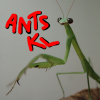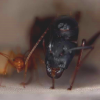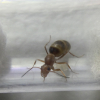OK, well, very long time and no update.
The truncorum died.
I now have 5 truncorum queens in a group with eggs. They all have wings, but none of them are at the front of the teube as most infertile ones do. Hopefully they are fertile.
Onto the plebeius.
My goodness, this colony has tested me. They have been growing and growing like crazy, eventually reaching about a thousand workers. (I did move them into the new formicarium).
A couple weeks ago, they had a bit of an escape. The tube connecting their nest to their outworld was accidentally unlplugged just barely, so they streamed out of the gap for a while. No issue, only about 100 workers escaped, and I got them all back in w/ my aspirator. That was nothing compared to what happened a week ago.
I woke up to hundreds of plebeius workers all over my ant desk, and with no easy to see trails, just everywhere. They had managed to chew a small hole in the acrylic next to the vinyl tubing. How they got thru the acrylic before the vinyl tubing, I frankly have no idea. Anyway, I aspirated most of them up, and dumped them back into their nest. I added a fluon layer to their outworld (which has held up since, thankfully) to make this easier, since there were still hundreds of workers in the outworld. I placed some rather nasty modelling clay which I thought they would not want to chew thru over the hole they created, and vowed to get my hot glue gun, and seal the hole later that day. I forgot to do this, and the next day, stumbled out of bed and went fishing with my parents for a few hours, it being July 4th and all, and came back to my ant desk once again covered in hundreds upon hundreds of workers. This time however, cleanup was a bit easier, as they had made trails, and mostly went for sugar water, and underneath the formicarium my Camponotus maritimus are in. I got most of them up, and sealed the hole with hot glue. As of yet, they have not chewed through the hot glue. I'm hoping beyond hope they never do.
They are at around 800 workers now with an uncountable amount of brood. They will be back over 1k in a week based on their pupa pile.
And right before I posted this, I checked on them, and bumped a cotton plug. 50+ workers escaped. 
Hi there! I went on a 6 month or so hiatus, in part due, and in part cause of the death of my colonies.
However, I went back to the Sierras, and restarted my collection, which is now as follows:
Aphaenogaster uinta, Camponotus vicinus, Camponotus modoc, Formica cf. aserva, Formica cf. micropthalma, Formica cf. manni, Formica subpolita, Formica cf. subaenescens, Lasius americanus, Manica invidia, Pogonomyrmex salinus, Pogonomyrmex sp. 1, Solenopsis validiuscula, & Solenopsis sp. 3 (new Sierra variant).





















